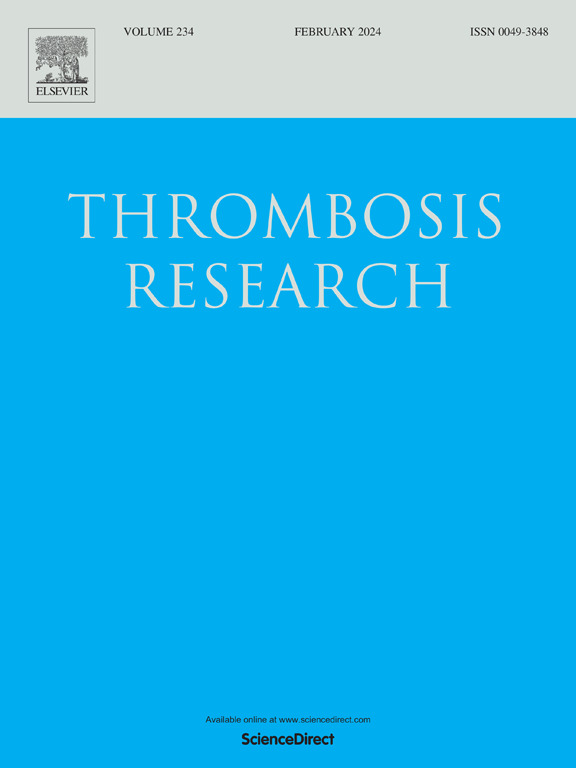Coagulopathy in Dabie bandavirus infection is related to endogenous heparinoids release and mast cells activation
IF 3.7
3区 医学
Q1 HEMATOLOGY
引用次数: 0
Abstract
Background
The prolonged activated partial thromboplastin time (APTT) and thrombin time in patients infected with Dabie bandavirus (DBV) have been recognized to be poor prognostic indicators and attributed to a heparin-like effect rather than a decrease in coagulation factor levels.
Objectives
To clarify the correlation between endogenous heparinoids and coagulopathy in patients infected with DBV, and their possible sources.
Methods
One hundred and twenty-one consecutive patients with confirmed DBV infection were enrolled in this prospective, single-center, observational study. Routine coagulation parameters, levels of syndecan-1, heparan sulphate (HS) and mast cell tryptase (MCT), and thrombin generation (TG) profile of these patients on admission were detected, and their outcomes were recorded.
Results
In the enrolled patients, prolonged APTT was associated with lower TG and higher levels of syndecan-1, HS and MCT (P < 0.05). There was a strong correlation between HS and MCT (r = 0.879, P < 0.001) and a weak correlation between HS and syndecan-1 (r = 0.252, P = 0.006). With the increase of viral load, both of the MCT and HS levels were significantly elevated, and levels of endogenous thrombin potential (ETP) was significantly decreased (P < 0.05). Age, ETP and MCT were independent predictors for 28-day mortality of patients infected with DBV (P < 0.05).
Conclusions
The coagulopathy in SFTS patients were related to decreased TG, endogenous heparinoids release and mast cells activation caused by DBV infection. Further study is needed to confirm whether blocking mast cells activation has the potential to improve their coagulopathy and prognosis.
大别班达病毒感染的凝血功能障碍与内源性肝素释放和肥大细胞活化有关
大别bandv (DBV)感染患者的活化部分凝血活素时间(APTT)和凝血酶时间延长已被认为是不良预后指标,并归因于肝素样效应而不是凝血因子水平降低。目的探讨内源性肝素与DBV患者凝血功能的关系及其可能的来源。方法连续121例确诊DBV感染的患者被纳入这项前瞻性、单中心观察性研究。检测患者入院时的常规凝血参数、syndecan-1、硫酸肝素(HS)、肥大细胞胰蛋白酶(MCT)水平及凝血酶生成(TG)情况,并记录其预后。结果在纳入的患者中,延长APTT与TG降低、syndecan-1、HS和MCT升高相关(P <;0.05)。HS与MCT有很强的相关性(r = 0.879, P <;HS与syndecan-1相关性较弱(r = 0.252, P = 0.006)。随着病毒载量的增加,MCT和HS水平均显著升高,内源性凝血酶电位(ETP)水平显著降低(P <;0.05)。年龄、ETP和MCT是DBV感染患者28天死亡率的独立预测因子(P <;0.05)。结论SFTS患者凝血功能障碍与DBV感染引起的TG降低、内源性肝素释放和肥大细胞活化有关。阻断肥大细胞活化是否有可能改善其凝血功能和预后,还需要进一步的研究来证实。
本文章由计算机程序翻译,如有差异,请以英文原文为准。
求助全文
约1分钟内获得全文
求助全文
来源期刊

Thrombosis research
医学-外周血管病
CiteScore
14.60
自引率
4.00%
发文量
364
审稿时长
31 days
期刊介绍:
Thrombosis Research is an international journal dedicated to the swift dissemination of new information on thrombosis, hemostasis, and vascular biology, aimed at advancing both science and clinical care. The journal publishes peer-reviewed original research, reviews, editorials, opinions, and critiques, covering both basic and clinical studies. Priority is given to research that promises novel approaches in the diagnosis, therapy, prognosis, and prevention of thrombotic and hemorrhagic diseases.
 求助内容:
求助内容: 应助结果提醒方式:
应助结果提醒方式:


